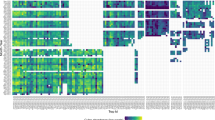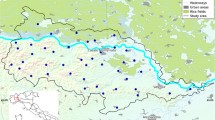Abstract
Modeling mosquito population dynamics has become an important part of understanding the transmission of mosquito-borne arboviruses. Of these models, those including meteorological variables have mainly focused on conditions during or immediately preceding the mosquito breeding season. While these conditions are clearly critical biologically and statistically, it is also biologically plausible that conditions during the off-season may contribute to interannual variation in mosquito population size. To examine the effect of off-season factors, we develop a pair of Poisson regression models for July captures of Aedes sollicitans and Culex salinarius, two East Coast vector species of arboviruses including Eastern equine encephalitis virus and West Nile virus. Model results indicate that average maximum temperature, total heating degree-days, and the total number of days with a minimum temperature below freezing during the winter months was predictive of mosquito populations. In addition, the average maximum relative humidity from the preceding fall and total rainfall and total heating degree-days during the preceding spring were also associated with vector population dynamics. The descriptive and predictive power of these models is discussed.
Similar content being viewed by others
References
Cameron AC and Windmeijer FA (1997). An R-squared measure of goodness of fit for some common nonlinear regression models. J Econ 77: 329–342
Chase JM and Knight TM (2003). Drought-induced mosquito outbreaks in wetlands. Ecol Lett 6: 1017–1024
Curriero FC, Shone SM and Glass GE (2005). Cross correlation maps: A tool for visualizing and modeling time lagged associations. Vector Borne and Zoonotic Dis 5: 267–275
Evans HT (1987). Use of surveillance results for predicting the emergence of salt marsh mosquito broods. J Fla Anti-Mosquito Assoc 58: 28–33
Focks DA (1993a). Dynamic life table model for Aedes aegypti (Diptera, Culcidae) - simulation and validation. J Med Entomol 30: 1018–1028
Focks DA (1993b). Dynamic life table model for Aedes aegypti (Diptera, Culicidae) - analysis of the literature and model development. J Med Entomol 30: 1003–1017
McCullagh P and Nelder JA (1983). Generalized linear models. Chapman and Hall, London
Mogi M (1996). Overwintering strategies of mosquitoes (Diptera: Culicidae) on warmer islands may predict impact of global warming on Kyushu, Japan. J Med Entomol 33: 438–444
Nasci RS (1993). Eastern equine encephalitis virus in Ohio during 1991. J Med Entomol 30: 217–222
Nayar JK, Rosen L and Knight JW (1986). Experimental vertical transmission of Saint Louis encephalitis virus by Florida mosquitoes. Am J Trop Med Hyg 35: 1296–1301
O’Leary DR (2002). West Nile virus activity – United States, 2001. MMWR 51: 497–501
O’Meara GF (1992) The eastern saltmarsh mosquito Aedes sollicitans. Wing Beats 3:5
R Development Core Team (2004) R: A language and environment for statistical computing. R Foundation for Statistical Computing, Vienna, Austria. http://www.R-project.org
Sakamoto Y, Ishiguro M and Kitagawa G (1986). Akaike information criterion statistics. Kluwer, Dordrecht
Shone SM et al. (2006) Characterizing the population dynamics of Aedes sollicitans (Diptera: Culicidae) using meteorological data. J Med Entomol 43:393–402
Slaff M (1990) The biology of Culex salinarius. Proceedings of the New Jersey Mosquito Control Association, pp. 71–72
Turell MJ (2001a). Potential North American vectors of West Nile virus. Ann NY Acad Sci 951: 317–324
Turell MJ (2001b). Vector competence of North American mosquitoes (Diptera: Culicidae) for West Nile virus. J Med Entomol 38: 130–134
Wegbreit J and Reisen WK (2000). Relationships among weather, mosquito abundance and encephalitis virus activity in California: Kern County 1990-98. J Am Mosq Control Assoc 16: 22–27
Author information
Authors and Affiliations
Corresponding author
Rights and permissions
About this article
Cite this article
Walsh, A.S., Glass, G.E., Lesser, C.R. et al. Predicting seasonal abundance of mosquitoes based on off-season meteorological conditions. Environ Ecol Stat 15, 279–291 (2008). https://doi.org/10.1007/s10651-007-0056-6
Received:
Revised:
Published:
Issue Date:
DOI: https://doi.org/10.1007/s10651-007-0056-6




